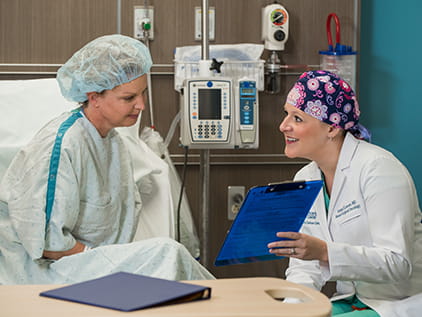May 20, 2020
Cynthia Garner, 62, exudes positivity. She's a power walker who eats right and has never smoked. That’s why yearly mammograms did not intimidate her. After more than 20 years of normal scans, she expected the same in late 2018.
But that’s when life changed for the Overland Park woman.
Based on a minor abnormality from her mammogram, her primary care team at The University of Kansas Health System’s Shawnee, Kansas, location sent Cynthia to The University of Kansas Cancer Center. The breast cancer team performed a repeat mammogram, followed by an ultrasound. “They got me in for a biopsy the same day,” she says.
A few days later, Cynthia received the phone call no woman wants. She had a type of breast cancer often missed on traditional mammograms. It’s called invasive lobular carcinoma.
Stopped in her tracks
“You could have knocked me over, I was so shocked,” says Cynthia. “I called my brother, Forrest Brown, right away. He’s a prostate cancer survivor and I needed him to talk me off the ledge.”
Breast surgical oncologists say it’s not unusual for a healthy woman to get breast cancer. That’s why annual mammograms performed by radiologists who specialize in breast disease are so important.
In Cynthia’s case, the cancer team went a step further. They ordered an MRI to analyze her tumor in greater detail. The MRI revealed Cynthia’s primary tumor was 3 times larger than initially suggested on the mammogram and ultrasound.
The MRI also showed she had separate tumors near the main tumor. Her breast surgical oncologist, breast radiation oncologist and breast medical oncologist Anne O’Dea, MD, recommended lumpectomy surgery followed by radiation therapy.
Her breast care team noted there are nuanced issues to consider in patients. Sometimes a lumpectomy is the right choice. Sometimes, a mastectomy. Dedicated, fellowship-trained breast surgeons, such as those at the cancer center, are more likely to optimize the balance between successful tumor removal and excellent cosmetic result.
One step forward, 2 steps back
During surgery, her breast surgical oncologist successfully removed the tumor as planned. But she also found cancer cells in the surrounding lymph nodes. That meant Cynthia would require chemotherapy to prevent the cancer from spreading further.
“When I got the call telling me I needed chemo, I was on my way to buy a sports bra. I went ahead and got the bra. I was not going to let this get me down,” she says.
Every member of The University of Kansas Cancer Center staff who interacted with Cynthia described her as a positive force. “Even when I had to give her bad news, she moved quickly into the mindset of ‘it is what it is’ and ‘let’s get going!’” says her breast surgical oncologist.
Powering through
Cynthia went through 16 rounds of chemotherapy and lost all her hair. “I tried scarves, hats and wigs, but that just wasn’t me. So, I went bald. My co-workers were so supportive and gracious,” she says. “My son said I looked like a Wakanda princess warrior from the Black Panther movie.”
Cynthia would need superhero courage to persevere through her year-long journey with cancer. In July, she was buoyed by a visit from her son, Technical Sargent Quincy Garner, who had been stationed with the USAF in Germany. He brought his wife, Sophia; son, Ellington; and 6-month-old daughter, Simone.
“It was the first time I got to hold my granddaughter,” remembers Cynthia. “I had planned to be in Germany in early 2019 for her birth, but I chose to stay here and fight cancer instead."
After chemotherapy, Cynthia continued her fight. She wanted to do everything possible to make sure she would be around to watch her beautiful grandchildren grow up. So, she began the latest radiation regimens. The right approach can reduce the length of treatment, cost and toxicity, while maximizing cure potential.
Celebrating survivorship
Cynthia finished treatment at the end of September 2019. Today, she has a clean bill of health with no evidence of cancer.
“My energy is back. I’m able to speed walk 4 miles a day again,” she says.
Cynthia’s spectacular outcome is a result of advanced multidisciplinary care, including imaging, surgery and postoperative therapies. She also credits faith, family and friends.
“It was wonderful to be with my family at Christmas with all the treatments behind me,” says Cynthia. “Cancer is not easy. You have to push through it. But there’s life on the other side – and a wonderful new hairdo!”

Your best option for beating cancer
The Women’s Cancer Center at The University of Kansas Cancer Center focuses on breast and gynecologic cancers, providing specialized care to women.
